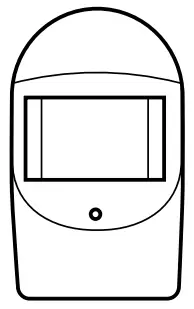
BUNKER HILL SECURITY RL-9816B Wireless Security Alert System User Manual

PACKAGE CONTENTS
- Indoor Unit
(Receiver) *1

- Outdoor Unit
(PIR Transmitter) *1

- Screw pack *1

- User manual *1

Indoor Unit (Receiver)

Outdoor Unit (Transmitter)

FEATURES
- This product adopts the professional IC for wireless transmitter and receiver and adopts learning code technology for easy operation. One million addresses effectively avoid interference.
- When the passive infrared (PIR) transmitter detects thermal signals (for example, human motions), it will send a wireless signal to the indoor unit and then the indoor unit will give “Ding-Dong, Ding Dong” tones and the indicator light will flash twice to remind the user.
OPERATION
- Learning Code:
- Insert batteries to the indoor unit.

- Slide the volume switch to LO or HI position, the indoor unit will give a “Ding-Dong” tone and its indicator light will flash to indicate batteries are installed properly.

- Insert a battery to the outdoor unit to trigger the PIR , its indicator light will flash red and at the same time will send a wireless signal to the indoor unit.

- When the indoor unit receives the wireless signal, it will give a “Ding-Dong” tone and its indicator light will flash to indicate the pairing has been successful.

- Insert batteries to the indoor unit.
- Clearing Code:
Turn off the indoor unit, it will clear the code for the paired transmitter. Therefore, each time you
turn off the indoor unit, you should pair the transmitter to the receiver again by following the instructions above. - Indoor Unit’s DC Power Plug (Optional):
Power requirements: 5V/6V 500mA. When DC power plug is selected, remove batteries from the compartment. - Indicator Light:
Indoor Unit
Working indicator: The indicator light will flash according to the indicator tone. Low battery: The indicator light in the middle will stay on constantly when the voltage is < 3.5V.
Outdoor Unit
Working indicator: The indicator light will turn on for 2 seconds when the PIR is triggered. Low battery: The indicator light will stay on constantly when the voltage is < 5V.
NOTE: When the light indicates low battery, the standby current will increase and the user should replace the batteries asap. When the batteries are going to run out, the indicator light will turn dim gradually and then turn off.
- Outdoor Unit’s PIR:
- The time interval for each trigger is about 13 seconds.
- Avoid direct sunlight when installing the outdoor unit. The sunlight may cause PIR give false alarm.
TECHNICAL SPECIFICATIONS
Indoor Unit (Receiver)
| Working Voltage | DC 4.5V (LR14 *3) |
| DC Power | 5V/6V 500mA |
| Working Current | <200mA |
| Standby Current | <180uA |
| Low Voltage Indicator | <3.5V±0.2V |
| Alarm Volume | HI:>90dB LO:>70dB |
| Demodulation | OOK |
| Wireless Frequency | 433.92MHZ±250KHz |
| Working Distance | ≥ 100m(no barrier) |
| Receiving sensibility | -105dBm |
| Working temperature | -15~60℃ |
Outdoor Unit (Transmitter)
| Working Voltage | DC 9V Alkaline battery(G6F22*1) |
| Working Current | <15mA |
| Standby Current | <50uA |
| Low battery indicator | <5V±0.2V |
| PIR detecting distance | 0-8m |
| PIR detecting angle | 0°- 40° |
| Transmitting time | ≈2s |
| Trigger time interval | ≈13±2s |
| Working Distance | ≥ 100m |
| Antenna gain | -2~3dBi |
| Working temperature | -15~60℃ |
TROUBLESHOOTING
- The main unit false alarms.
Check if any animals are in the vicinity of the PIR sensor, During warm weather moving shadows may also activate the alarm. Make sure that the PIR sensor is not positioned near a radiator or heat source. - When the PIR alarm detects movement, however, no alarm sounds.
- Check if the pairing between the transmitter and the main unit has been successful.
If the pairing was successful, check the battery voltage for both the main unit and the transmitter. Low voltage will cause the product to fail. - When installing, keep the distance between the transmitter and receiver is proper and note that obstructions may reduce the receiving range.
- Check if the pairing between the transmitter and the main unit has been successful.
TIPS
- Recommended installation height: 1.6±0.3m, adjust the installation angle to face downward.
- Do not install the product in direct sunlight or close to a radiator or heat source.
- The detection range of the PIR alarm may vary slightly due to different environments.
- Do not attempt to repair this product, please return to your retailer
- Remove batteries if the product is not in use for a long time and dispose the batteries according to the local laws and regulations.
 Do not mix old and new batteries
Do not mix old and new batteries- Do not mix alkaline, standard (carbon-zinc), or rechargeable (ni-cad, ni-mh, etc.) batteries
FCC STATEMENT
Warning: Changes or modifications to this unit not expressly approved by the party responsible for compliance could void the user’s authority to operate thee equipment.
NOTE: This equipment has been tested and found to comply with the limits for a Class B digital device, pursuant to Part 15 of the FCC Rules. These limits are designed to provide reasonable protection against harmful interference in are identical installation. This equipment generates, uses and can radiate radiofrequency energy and, if not installed and used in accordance with the instructions, may cause harmful interference to radio communications. However, there is no guarantee that interference will not occur in a particular installation. If this equipment does cause harmful interference to radio or television reception, which can be determined by turning the equipment off and on, the user is encouraged to try to correct the interference by one or more of the following measures:
- Reorient or relocate the receiving antenna.
- Increase the separation between the equipment and receiver.
- Connect the equipment into an outlet on a circuit different from that to which the receiver is connected.
- Consult the dealer or an experienced radio/TV technician for help.
The device must not be co-located or operating in conjunction with any other antenna or transmitter.
This device complies with Part 15 of the FCC Rules. Operation is subject to the following two conditions:
- this device may not cause harmful interference, and
- this device must accept any interference received, including interference that may cause undesired operation.